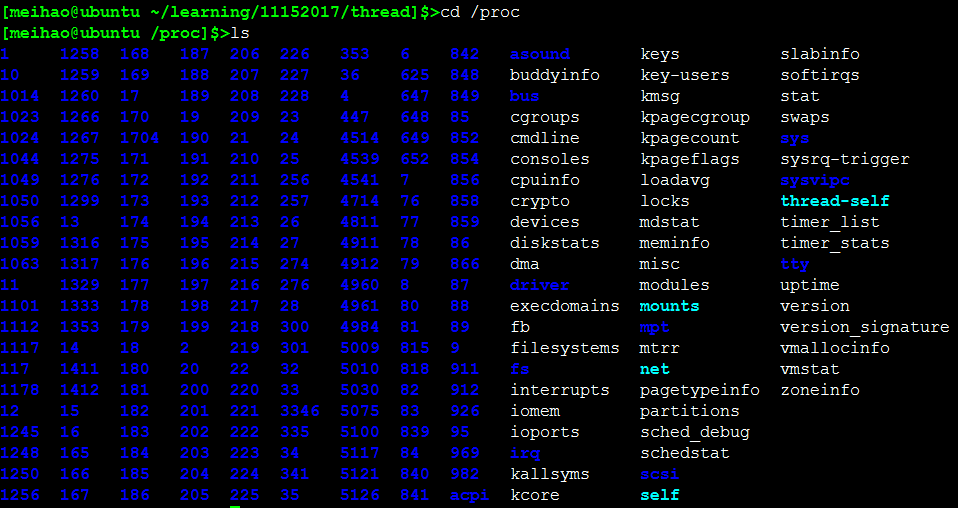1. 线程的创建和退出
创建线程实际上就是确定调用该线程函数的入口点,线程的创建采用函数 pthread_create。在线程创建以后,就开始运行相关的线程函数,在该函数运行完之后,线程就退出,这也是线程退出的一种方式。另一种线程退出的方式是使用函数 pthread_exit() 函数,这是线程主动退出行为。这里要注意的是,在使用线程函数时,不能随意使用exit退出函数进行出错处理,由于exit的作用是使调用进程终止,往往一个进程包括了多个线程,所以在线程中通常使用 pthread_exit 函数来代替进程中的退出函数exit。
由于一个进程中的多个线程是共享数据段的,因此通常在线程退出之后,退出线程所占用的资源并不会随着线程的终止而得到释放。正如进程之间可以通过wait()函数系统调用来同步终止并释放资源一样,线程之间也有类似的机制,那就是 pthread_join 函数。pthread_join 函数可以用于将当前线程挂起,等待线程的结束。这个函数是一个线程阻塞函数,调用它的函数将一直等待直到被等待的线程结束为止,当函数返回时,被等待线程的资源被回收。
函数原型:
#include <pthread.h>
int pthread_create(pthread_t* thread, pthread_attr_t * attr, void *(*start_routine)(void *), void * arg);
void pthread_exit(void *retval);
通常的形式为:
pthread_t pthid;
pthread_create(&pthid,NULL,pthfunc,NULL); 或
pthread_create(&pthid,NULL,pthfunc,(void*)3);
pthread_exit(NULL); 或
pthread_exit((void*)3); //3作为返回值被pthread_join函数捕获。
函数pthread_create用来创建线程。返回值:成功,则返回0;失败,则返回对应错误码。各参数描述如下:
·参数thread是传出参数,保存新线程的标识;
·参数attr是一个结构体指针,结构中的元素分别指定新线程的运行属性,attr可以用pthread_attr_init等函数设置各成员的值,但通常传入为NULL 即可;
·参数start_routine是一个函数指针,指向新线程的入口点函数,线程入口点函数带有一个void *的参数由pthread_create的第4个参数传入;
·参数arg用于传递给第3个参数指向的入口点函数的参数,可以为NULL,表示不传递。
函数pthread_exit表示线程的退出。其参数可以被其它线程用pthread_join函数捕获。|
1、在线程库里不能使用perror函数查看错误
2、能够perror的函数,函数失败以后,修改了全局变量
errno,perror读取error,显示错误
主线程退出,文件描述符关闭,进程地址空间清理
|
| pthread_creat.c | pthread_creat_val.c |
|
#include<stdio.h>
#include<pthread.h>
void* threadfunc(void*p)
{
printf("I am a child thread\n");
while(1);
}
int main()
{
pthread_t thdid;
pthread_create(&thdid,NULL,threadfunc,NULL);
while(1);
return 0;
}

|
#include<stdio.h>
#include<pthread.h>
void* threadfunc(void*p)
{
int i;
i=(int)p;
printf("I am a child thread %d\n",i);
while(1);
}
int main()
{
pthread_t thdid;
pthread_create(&thdid,NULL,threadfunc,(void*)1);
while(1);
return 0;
}

|
 //进程相同,所以父进程也相同(4961),但是线程号不相同 5100、5101
//进程相同,所以父进程也相同(4961),但是线程号不相同 5100、5101


 //这里面就是我们的线程
//这里面就是我们的线程
| pthread_creat_arg1.c | |
|
#include<stdio.h>
#include<pthread.h>
#include<string.h>
#include<stdlib.h>
#include<unistd.h>
void *thread_func(void *p)
{
strcpy((char*)p,"hello,world!");
printf("I am child thread , p's address = %p\n",p);
printf("child thread p=%s\n",(char*)p);
return 0;
}
int main(void)
{
pthread_t pt_id;
void *p = malloc(20*sizeof(char));
pthread_create(&pt_id,NULL,thread_func,p);
printf("p's address = %p\n",p);
//%p 打印指针地址
sleep(2);
printf("main thread , p=%s\n",(char*)p);
return 0;
}
| // %p // %x  |
| pthread_exit.c | |
|
#include<stdio.h>
#include<pthread.h>
#include<string.h>
#include<unistd.h>
void* threadfunc(void*p)
{
strcpy((char*)p,"hello");
printf("I am a child thread %s\n",(char*)p);
printf("child p is %x\n",p);
pthread_exit((void*)0); //退出值是0,就可以直接写NULL,表示没有返回值
}
int main()
{
pthread_t thdid;
void* p=malloc(20);
printf("p is %x\n",p);
printf("I am a father thread %s\n",(char*)p); //线程共享资源,这里字符串打印的是空的
int ret = pthread_create(&thdid,NULL,threadfunc,p);
if(ret!=0)
{
printf("error pthread_create\n");
return -1;
}
sleep(1);
printf("I am a father thread after sleep %s\n",(char*)p);
return 0;
}
|  |
2. 线程的等待退出
等待线程退出:
线程从入口点函数自然返回,或者主动调用pthread_exit()函数,都可以让线程正常终止。
线程从入口点函数自然返回时,函数返回值可以被其它线程用pthread_join函数获取。
pthread_join原型为:
#include <pthread.h>
int pthread_join(pthread_t th, void **thread_return);
1.该函数是一个阻塞函数,一直等到参数 th 指定的线程返回;与多进程中的wait或waitpid类似。
thread_return是一个传出参数,接收线程函数的返回值。如果线程通过调用pthread_exit()终止,则 pthread_exit() 中的参数相当于自然返回值,照样可以被其它线程用pthread_join()获取到。
2.thid传递0值时,join返回ESRCH错误。
| pthread_exit(int).c | |
|
#include <pthread.h>
#include <stdio.h>
#include <stdlib.h>
#include <string.h>
#include <unistd.h>
void* thread(void* p)
{
strcpy((char*)p,"hello");
printf("I am child thread\n");
printf("child p is %p\n",p);
pthread_exit((void*)5); //通过pthread_exit实现线程退出,没有返回值,就写pthread_exit(NULL);
}
int main()
{
pthread_t th_id;
void* p=malloc(20);
printf("p is %p\n",p);
int ret=pthread_create(&th_id,NULL,thread,p); //创建线程,将数值放入指针内
if(ret!=0)
{
printf("pthread_create failed ret=%d\n",ret);
return -1;
}
int i;
//void *i; //申请了一块内存,void *,到时候把这个传给下面函数,函数操作会给你这块内存自己定好偏移,附上值,也就是这块地址开始的内存里就存的是上面退出的5;所以最后能直接(int)i;
ret=pthread_join(th_id,(void**)&i); //函数规定第二个形参要是一个void**,i来接数据,所以必须取地址
//要用 i 来接返回值,也就是要改变 i 所以必须取地址,但是取完一次地址就不能再取地址,最后转成(void**);
if(ret!=0)
{
printf("pthread_join failed ret=%d\n",ret);
return -1;
}
printf("main thread %s\n",(char*)p);
printf("main thread i=%d\n",i);
//printf("main thread i=%d\n",(int)((int*)i));
//printf("main thread i=%d\n",(int)i);
return 0;
}
|  |
| pthread_malloc.c | |
|
#include <pthread.h>
#include <stdio.h>
#include <stdlib.h>
#include <string.h>
#include <unistd.h>
void* thread(void* p)
{
p=malloc(20);
strcpy((char*)p,"hello");
printf("I am child thread\n");
printf("child p is %p\n",p);
return p;
}
int main()
{
pthread_t th_id;
int ret=pthread_create(&th_id,NULL,thread,NULL); //创建线程,将数值放入指针内
if(ret!=0)
{
printf("pthread_create failed ret=%d\n",ret);
return -1;
}
char* p; //void* p;
ret=pthread_join(th_id,(void**)&p); //要改变p所存的地址,所以&p
if(ret!=0)
{
printf("pthread_join failed ret=%d\n",ret);
return -1;
}
printf("p = %p\n",p);
printf("p = %s\n",p); //(char*)p
return 0;
}
|  |





















 198
198

 被折叠的 条评论
为什么被折叠?
被折叠的 条评论
为什么被折叠?








